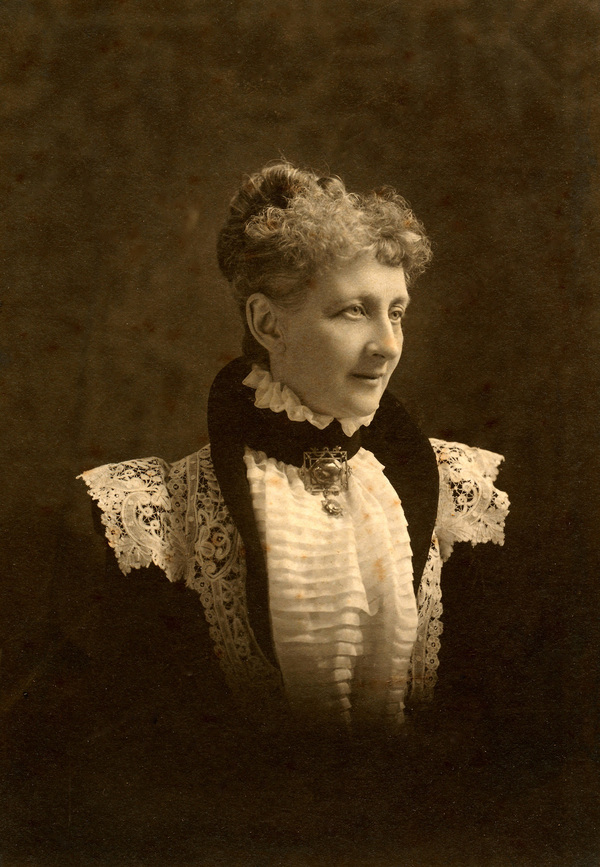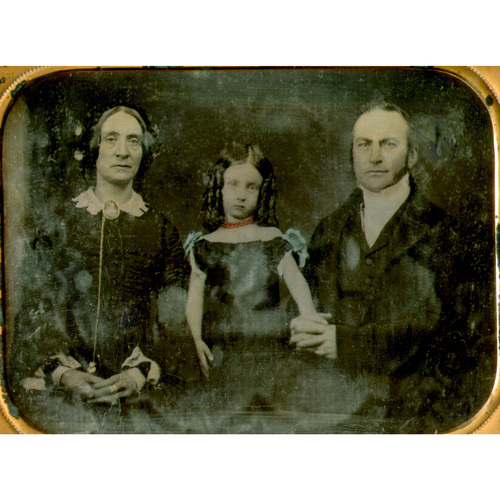
Source: Link
BAKER, MARY JANE (McQuesten), social activist; b. 10 Oct. 1849 in Brantford, Upper Canada, daughter of Thomas Baker and his second wife, Mary-Jane McIlwaine; m. 18 June 1873 Isaac Baldwin McQuesten in Toronto, and they had five daughters, one of whom died in infancy, and two sons; d. 7 Dec. 1934 in Hamilton, Ont.
Mary Baker’s father had been in the Royal Navy before becoming a minister. A Calvinist with a strong missionary spirit, in 1835 he went to Upper Canada to serve at the first Congregational Church in Kingston. Throughout his pastorate, which took him to Paris, Brantford, and Newmarket, he spoke in defence of women’s right to be educated and to participate in church meetings. Religious and military values such as morality, discipline, and social responsibility were impressed upon young Mary, who would develop the courage to be outspoken and to voice her frustration with men of authority. She received a classical education and earned good grades, initially at Newmarket County Grammar School and then at a ladies’ collegiate run by a “Mrs. Dr. Burns” in Toronto.
Mary wedded Isaac Baldwin McQuesten, a young lawyer with excellent prospects and son of wealthy Hamilton industrialist Calvin McQuesten*. The elder McQuesten had retired with some $500,000 in 1857, when he was 56. He gradually passed control of his finances to Isaac. After Calvin’s death in 1885, Isaac inherited Willowbank, his father’s stately home, which Mary promptly renamed Whitehern. But by 1887 the couple’s fortunes had changed. The family assets had been wiped out by Isaac’s bad investments; depressed, he began drinking heavily, a habit that had at least once before threatened his relationship with Mary, and he was probably taking opiates as well. He received treatment from Dr Stephen Lett* at the Homewood Retreat near Guelph. In a letter to his half-brother Calvin Brooks McQuesten, Isaac confessed that he often experienced “unhealthful excitement” followed by “sluggishness”; at least two of his children appear to have suffered from mental illness, and Mary herself would seek treatment after a breakdown in 1897.
Isaac died at home suddenly on 7 March 1888, at the age of 40, reportedly from a combination of medications, sleeping draughts, and alcohol. The death was rumoured to be a suicide, especially since he was bankrupt, with debts totalling $900,000 and assets of $9,000. Left with six children between the ages of 2 and 14, and scarcely anything in the way of resources (some bank stocks and income from a few rental properties), Mary took charge of her family. She believed that Ruby Baker and Thomas Baker* were capable of achieving professional careers, but only the boy was likely to make a good salary and restore the family’s social standing. Since there was little money to pay for his education, Mary decided that Ruby, who was older, would take a job as a teacher at a Presbyterian college in Ottawa – Mary had embraced Presbyterianism after her marriage – and send a large portion of her wages home for Tom’s university tuition. Ruby continued working long after she developed a chronic cough and in 1911, just four years after her brother had graduated and begun to earn an income, she died of tuberculosis.
The McQuesten children, none of whom would ever marry, remained close to Mary and her moral influence throughout their lives. The eldest, Mary Baldwin, was neither scholarly nor “fitted,” her mother declared, for marriage; she took up church work and did the housekeeping with her sister Hilda-Belle, who led a similarly cloistered life. The latter’s one marriage prospect was thwarted by Mary, a fervent temperance advocate, upon learning that the suitor, a salesman, treated other men to alcohol as part of his job. Margaret Edna had won a scholarship to Queen’s College in Kingston in 1904, but was unable to complete her studies because of her fragile mental state. Her “nervous condition” and episodes of hysteria were a frequent cause for concern. In a letter written in 1905, after Edna had been sent away for treatment, Mary, ever conscious of the stigma already surrounding her family, advised her son Calvin that “we do not mention her name unless people ask after her particularly.” Calvin too was psychologically and physically frail. In 1896 he fell under the influence of faith healer John Alexander Dowie in Chicago. He returned to Canada following his “rebirth,” attempted a degree, worked as a journalist, tried homesteading in western Canada, and served as a minister there and in Ontario and Quebec (he resigned two positions in three years because of “insomnia”); two books he wrote on religious themes were never published.
When her children were studying or working away from home, M. B. McQuesten, as she signed herself, wrote to them constantly and many of her letters are extant. It is in this body of correspondence that her role as strict Victorian matriarch and her efforts to mould the children according to her Presbyterian values are revealed. In one letter she reminded Thomas of the need “to strive and pray earnestly … to attain what our Saviour expects of us.” In another she related local gossip: “Mrs. Bennett tells that Dr. Barclay’s sons are very wild and drink terribly. It is a sad world.” Personal worries, such as the family’s financial and health concerns, were often discussed. But Mary dealt too with more pleasant topics, including her work with missionary societies and the state of her garden. In the spring of 1915 she wrote, “The shrubs are fine this year the winter season was so mild, forsythia very good and japonica, flowering, prune hurrying out too, as well as tulips.”
Despite the many difficulties she faced in raising six children single-handed, Mary devoted much time and energy to religious and social causes. An active member for over half a century of the Woman’s Foreign Missionary Society of the Presbyterian Church in Canada (Western Division) [see Marjory Laing*], she worked tirelessly on its behalf and served for 25 years as president of the Hamilton presbyterial of the WFMS; she was also involved with the Women’s Missionary Society of the MacNab Street Presbyterian Church (where she worshipped) and the Women’s Home Missionary Society. In 1906 Mary journeyed throughout Ontario and the west, establishing WFMS auxiliaries and inspecting mission schools, including that in the File Hills Colony, Sask. [see William Morris Graham]. She helped found the Young Women’s Christian Association in Hamilton to address the needs of young women travelling unaccompanied; it would later become famous for its school of domestic science [see Adelaide Sophia Hunter*]. She also belonged to the National Council of Women of Canada; however, likely because the organization lacked a clear Christian thrust (its members decided not to open their meetings with public prayer), she gave precedence to her other affiliations. In 1923, at age 73, she lectured publicly against church union [see Clarence Dunlop Mackinnon; Ephraim Scott], which she said would dissolve the Presbyterian Church into the United Church of Canada and consign it to “obscurity.” “If we women can’t get into the general assembly and have a vote,” she maintained, “we are going to show them that we can do something to block this church union.” She was probably concerned in particular about the threatened loss of autonomy of women’s mission societies under the proposal. While church union would not be blocked, about one-third of Presbyterian churches, Mary’s included, refused to join the United Church.
Mary died of a cerebral haemorrhage on 7 Dec. 1934. Tom, who had become an mla, a provincial cabinet minister under Mitchell Frederick Hepburn*, and a Hamilton booster known especially for his work in developing the city’s parks, always paid tribute to his mother’s role in shaping his tastes and outlook. As her obituary in the Hamilton Herald noted: “Not the least of her contributions to him was to give him a love for beauty that was large enough to spread out and influence the appearance of a great city.… Large areas of Hamilton are, in the last analysis, a reflection of her love of beauty.” On the death of Calvin, the last surviving member of the family, Whitehern was bequeathed to the city of Hamilton with its contents intact, and it became a museum in 1971. Bearing an Ontario historical plaque, the house stands as a tribute to the indomitable spirit of Mary Baker McQuesten.
More than 3,000 family letters, many of them written by Mary Jane Baker McQuesten to her children, have been preserved at Whitehern Historic House and Garden in Hamilton, Ont. This correspondence, which provides an unusually detailed look into the personal lives of an upper-middle-class family in the Victorian and Edwardian periods, is invaluable for the historian. Many of the letters can be found on the Whitehern Museum Arch. website, “An online history of the McQuesten family”: www.whitehern.ca (consulted 26 Jan. 2013), as well as in the author’s thesis, “The life writings of Mary Baker McQuesten (1849–1934): Victorian matriarch of Whitehern” (phd thesis, McMaster Univ., Hamilton, 2000), and the book she edited, The life writings of Mary Baker McQuesten: Victorian matriarch (Waterloo, Ont., 2004). The author’s book, Tragedy & triumph: Ruby & Thomas B. McQuesten, was published in Dundas, Ont., in 2011. Another source to consult for information about the family is DHB, vols.3–4; additionally, two full-length books have been written about one of Mary’s sons: Roland Barnsley, Thomas B. McQuesten (Markham, Ont., 1987) and J. C. Best, Thomas Baker McQuesten: public works, politics, and imagination (Hamilton, 1991). Ruth Compton Brouwer, New women for God: Canadian Presbyterian women and India missions, 1876–1914 (Toronto, 1990) and N. K. Clifford, The resistance to church union in Canada, 1904–1939 (Vancouver, 1985) are detailed studies of two of the issues in which Mary was active.
Cite This Article
Mary J. Anderson, “BAKER, MARY JANE (McQuesten),” in Dictionary of Canadian Biography, vol. 16, University of Toronto/Université Laval, 2003–, accessed December 31, 2025, https://www.biographi.ca/en/bio/baker_mary_jane_16E.html.
The citation above shows the format for footnotes and endnotes according to the Chicago manual of style (16th edition). Information to be used in other citation formats:
| Permalink: | https://www.biographi.ca/en/bio/baker_mary_jane_16E.html |
| Author of Article: | Mary J. Anderson |
| Title of Article: | BAKER, MARY JANE (McQuesten) |
| Publication Name: | Dictionary of Canadian Biography, vol. 16 |
| Publisher: | University of Toronto/Université Laval |
| Year of publication: | 2016 |
| Year of revision: | 2016 |
| Access Date: | December 31, 2025 |









